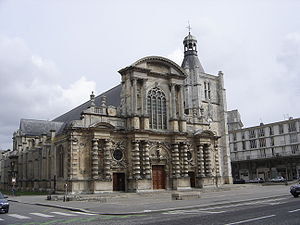
Le Havre Cathedral
Encyclopedia

Le Havre
Le Havre is a city in the Seine-Maritime department of the Haute-Normandie region in France. It is situated in north-western France, on the right bank of the mouth of the river Seine on the English Channel. Le Havre is the most populous commune in the Haute-Normandie region, although the total...
.
It was previously a parish church dating from the 16th and 17th centuries, and is the oldest of the very few buildings in central Le Havre to have survived the devastation of World War II
World War II
World War II, or the Second World War , was a global conflict lasting from 1939 to 1945, involving most of the world's nations—including all of the great powers—eventually forming two opposing military alliances: the Allies and the Axis...
. It became a cathedral and the seat of the Bishop of Le Havre in 1974, when the diocese of Le Havre was created.
The belltower dates from around 1520 and the main façade is Baroque
Baroque architecture
Baroque architecture is a term used to describe the building style of the Baroque era, begun in late sixteenth century Italy, that took the Roman vocabulary of Renaissance architecture and used it in a new rhetorical and theatrical fashion, often to express the triumph of the Catholic Church and...
. The building was kept unusually low because of the difficulties posed by the unstable ground.
The fine church organs were the gift of the Cardinal de Richelieu in 1637, when he was governor of the town.

